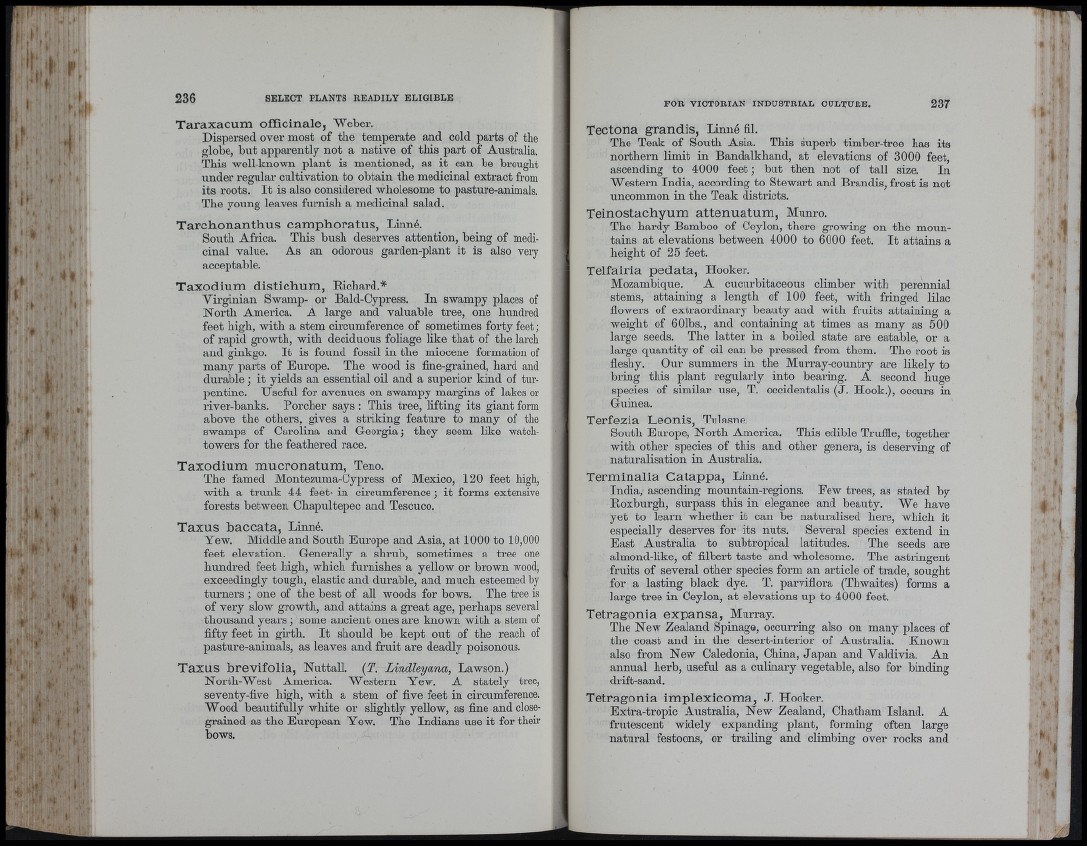
‘ »
Taraxacum officinale, Weber,
Dispersed over most of the temperate and cold parts of the
globe, but appai'ently not a native of this part of Australia.
This well-known plant is mentioned, as it can be brought
under regular cultivation to obtain the medicinal extract from
its roots. I t is also considered wholesome to pasture-animals.
The young leaves furnish a medicinal salad.
Tarchonanthus camphoratus, Linné.
South Africa. This bush deserves attention, being of medicinal
value. As an odorous garden-plant it is also very
acceptable.
Taxodium distichum, Richard.*
Virginian Swamp- or Bald-Cypress. In swampy places of
North America, A large and valuable tree, one hundred
feet high, with a stem circumference of sometimes forty feet;
of rapid growth, with deciduous foliage like that of the larch
and ginkgo. I t is found fossil in the miocene formation of
many pai’ts of Europe. The wood is fine-grained, hard and
durable; it yields an essential oil and a superior kind of tur-
loentine. Useful for avenues on swampy margins of lakes or
river-hanks. Porcher says : This tree, lifting its giant form
above the others, gives a striking feature to many of the
swamps of Carolina and Georgia; they seem like watch-
towers for the feathered race,
Taxodium mucronatum, Teno.
The famed Monteznma-Cypress of Mexico, 120 feet high,
with a trunk 44 feet- in circumference; it forms extensive
forests between Cliapnltepec and Tescuco.
Taxus baccata, Linné.
Yew. Middle and South Europe and Asia, at 1000 to 10,000
feet elevation. Generally a shrub, sometimes a tree one
hundred feet high, whicb furnishes a yellow or brown wood,
exceedingly tough, elastic and durable, and much esteemed by
turners ; one of the best of all woods for bows. The tree is
of very slow growth, and attains a great age, perhaps several
thousand years ; some ancient ones are known with a stem of
fifty feet in girth. I t should he kept out of the reach of
pasture-animals, as leaves and fruit are deadly poisonous.
Taxus brevifolia, Nuttall. [T. Lindleyana, Lawson.)
North-West America. Western Yew. A stately tree,
seventy-five high, with a stem of five feet in circumference.
Wood beautifully white or slightly yellow, as fine and close-
grained as the European Yew. The Indians use it for their
bows.
Tectona grandis, Linné fil.
The Teak of South Asia. This superb timher-tree has its
northern limit in Bandalkhand, at elevations of 3000 feet,
ascending to 4000 feet ; but then not of tall size. In
Western India, according to Stewart and Brandis, frost is not
uncommon in the Teak districts.
Teinostachyum attenuatum, Munro,
The hardy Bamboo of Ceylon, there growing on the mountains
at elevations between 4000 to 6000 feet. I t attains a
height of 25 feet,
Telfairia pedata. Hooker.
Mozambique. A cucurbitaceous climber with perennial
stems, attaining a length of 100 feet, with fringed lilac
flowers of extraordinary beauty and with fruits attaining a
weight of 601bs., and containing at times as many as 500
large seeds. The latter in a boiled state are eatable, or a
large quantity of oil can be pressed from them. The root is
fleshy. Our summers in the Muri'ay-country are likely to
bring this plant regularly into bearing. A second huge
species of similar use, T. occidentalis (J, Hook.), occurs in
Guinea.
Terfezia Leonis, Tulasne.
South Europe, North America. This edible Truffle, together
with other species of this and other genera, is deserving of
naturalisation in Australia.
Terminalia Catappa, Linné.
India, ascending mountain-regions. Few trees, as stated by
Roxburgh, surpass this in elegance and beauty. We have
yet to learn whether it can be naturalised here, which it
especially deserves for its nuts. Several species extend in
East Anstralia to subtropical latitudes. The seeds are
almond-like, of filbert taste and wholesome. The astringent
fruits of several other species form an article of trade, sought
for a lasting black dye. T. parviflora (Thwaites) forms a
large tree in Ceylon, at elevations up to 4000 feet.
Tetragonia expansa, Murray.
The New Zealand Spinage, occurring also on many places of
the coast and in the desert-interior of Australia. Known
also from New Caledonia, China, Japan and Valdivia. An
annual herb, useful as a culinary vegetable, also for binding
drift-sand.
Tetragonia implexicoma, J , Hooker,
Extra-tropic Australia, New Zealand, Chatham Island. A
frutescent widely expanding plant, forming often large
natural festoons, or trailing and climbing over rocks and